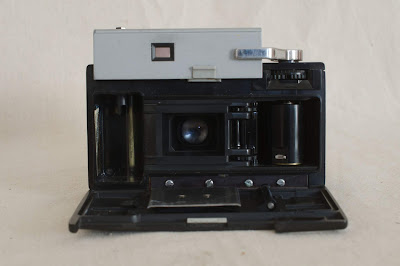Front
Back
Top
Film Chamber
Shutter Speed and Aperture Settings
Film Speed Setting
 |
| Flash Exposure Setting Guide |
Exposure automation in 35mm cameras began to be popular in the 1960s. "Electric eye" cameras used selenium cell light meters and electromechanical aperture diaphragms for shutter priority auto exposure. This camera has an f/2.8-f/22 50mm Argus Cintar lens in an imported German Compur shutter. The shutter speeds run from 1/500 second to 1/30 second plus bulb. The light meter can be set for ASA film speeds from 10 to 400. Film advance is by a single stroke lever. The back hinges down to open for loading film. The film counter should be manually set to the number of exposures on the roll, and counts down to zero. There is a rewind release lever on the bottom of the camera and a rewind crank on the top. The shape of the camera is reminiscent of the ever-popular C3 "Brick" and the mechanics are like the previous C33. The viewfinder has a coincident range finder with a triangular range finder patch. The camera focuses with a knob on the front surrounding the shutter release button. There is a threaded cable release socket in the shutter button. The matching flasholder plugs into the side of the camera. The camera is clunky and uncomfortable to hold.
Argus tried to eliminate any references to photographic esoterica like f-stops and shutter speeds. The lens barrel is marked with aperture numbers from 3 to 9 instead of f/2.8 to f/22. The shutter speed settings are marked "Flash", "Scene", "Action" and, in one concession to the photographic art, 500. The bulb setting for long exposures is not marked at all, but exists to the left of the "Flash" setting. The range finder knob is marked with flash setting numbers from 1 to 8 instead of feet. For flash photography the photographer was instructed to focus on the subject and then set the aperture to match the number on the range finder. The same method for setting flash exposure was used on the Match-Matic C3. The instruction book did give the shutter speed and f-stop equivalents to the camera markings for those who wanted to know.
The Autronics have a deserved reputation as unreliable cameras. Argus stopped making the Autronics in 1965, and the venerable C3 in 1966. The Argus branded cameras that followed were all made overseas. By the time the Autronics came out Argus had already dipped its toe into the import ocean by importing the V-100 camera and lenses for a number of cameras from West Germany. Argus as a brand name gradually faded away and the last incarnation of Argus is long out of business.






No comments:
Post a Comment